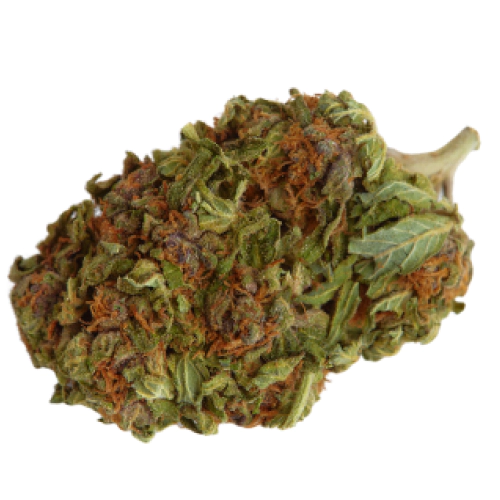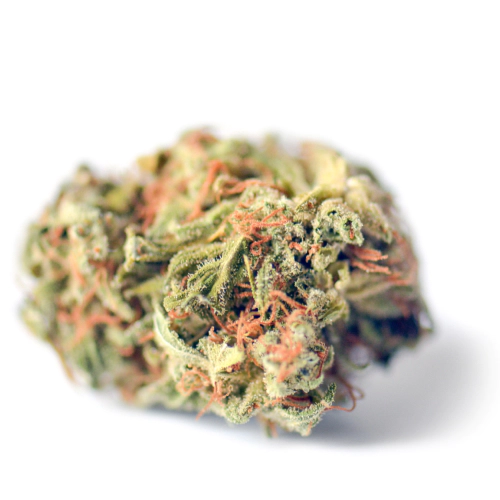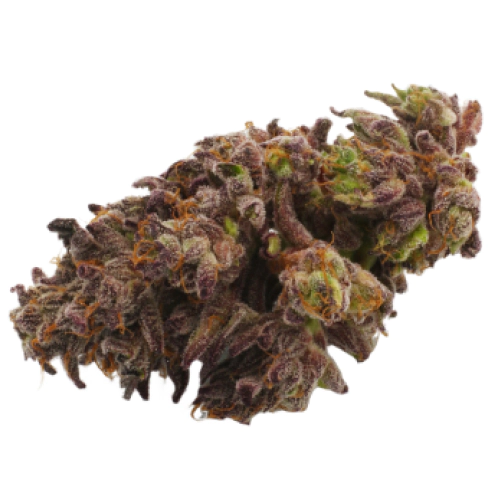THC 19 - 21.5%
CBD 0.22 - 0.57%
Effect Relaxed
Flavor Lemon
19.5 - 23%
0.32 - 0.64%
0.3 - 0.79%
Diesel, Earthy
Relaxed
Death Star strain, despite its terrific name, is a potent weed that will be a perfect match for smokers who prefer to stay high with couch locking qualities. It originated back in 2004, alongside growing in popularity among smokers who preferred strong THC Indica phenotypes with potent calming properties. By crossing Sensi Star and Sour Diesel, the two already famous phenotypes, Death Star possesses a dazzling array of features associated with its parents.
By possessing attributes of both phenotypes, this Indica-dominant hybrid strain can surprise both experienced and casual users.
Regarding THC content levels, it ranges from 18% to 21% in lab testing conditions, whereas the amount of CBD never reaches a mark beyond 1%. Such a high THC content is favorable for smokers who love Death Star to get high for a more extended time. Death Star cannabis strain has been described as a stunning adventure in most reviews, whereas its top ranks in High Times championships also make this weed an award-winning hybrid.
The strong odor of Death Star is remarkable, thanks to its pungent bud structure. The scent reminiscences an earthy and skunky smell, followed by diesel and sweet undertones. This alien-like combination highlights creaminess, orange, and citrus aroma undertones, which smoothly dissolve into a skunky, pungent, and earthy diesel palette.
When it comes to flavor, not only this skunky strain is reminiscent of creaminess and peppery diesel, but it also has strong earthy undertones that are easily recognizable.
This strain is famous for its lingering tastes that are sweet upon the tongue that remains for long, even after taking a few puffs. Inexperienced people can also say that it is a bit harsh, whereas more experienced ones will enjoy gentle lifts of smoke that fills lungs softly, without too much irritation to their throats.
This great strain has all the properties associated with Indica strains and a little Sativa effects:
Speaking of medicinal properties, one smoker should recognize that Death Star strain is not medical marijuana per se. Despite not holding this official title, its application for medicinal purposes is just incredibly vast. It is a great treatment for patients suffering from:
When it comes to side effects, Death Star possesses common attributes that are related to Indica strains with high THC content levels and low CBD ones. Smokers will most likely experience cottonmouth, dry eyes, and slight dizziness.
One attribute that makes this kush a respected strain among growers is its ease of growing. Not only this strain produces immense yields, but it also requires little effort thanks to its resistance to mold and mildews. The crop is short in size, meaning that growers wouldn’t have to find much extra space to expand their yields.
It has a short cycle to be fully grown with a flowering period that lasts around 9 to 10 weeks. Since Death Star can be used for growing both outdoors and indoors, the usual yields are 12 and 14 ounces per square meter, respectively.
Those who are fond of growing outdoors should expect to harvest Death Star closer to early to mid-October. Although we recommend growing it indoors, you should remember that in order to produce Death Star properly, you should check light and humidity levels to achieve the best yield results.
| THC | Tetrahydrocannabinol, or THC, is a major cannabis chemical compound. It is a psychoactive element that stimulates dopamine release and induces euphoria or happiness. THC-rich strains may be helpful with such conditions as lack of appetite, chronic pains , etc. It is considered to be the primary active marijuana component. | 19.5 - 23% |
| CBD | Cannabidiol, or CBD, is a major compound in cannabis, which is non-psychoactive. It is also proved to counteract the side effects of the second major component THC. CBD is widely used for medicinal purposes in rubs, oils and so on. It is helpful in muscle pain cases, may treat arthritis and migraines. Even Greeks used it against pain, while Queen Victoria applied it to get rid of menstrual cramps. | 0.32 - 0.64% |
| CBC | Cannabichromene, or CBC, is a minor cannabinoid, meaning that its quantity in cannabis is quite little. Though it has the same origin as CBD and THC, it is different in functions. Without any psychoactive effects, it is an efficient cannabis compound in combating acne and depression. CBC produces analgesic, antibacterial and anti-inflammatory effects. | 0.06 - 0.46% |
| CBG | Cannabigerol, or CBG, is one of the minor cannabis compounds in adult plants. On the other hand, young ones contain a lot of this antibacterial and anti-inflammatory component. During the growth, CBG is converted into different cannabinoids, mostly THC and CBD. The compound itself increases appetite and decreases eye pressure. | 0.3 - 0.79% |
| CBN | Cannabinol, or CBN, is a trace element in cannabis that is considered to be mildly psychoactive. It appears from oxidation THC, exposed to light and heat. CBN is mostly contained in old cannabis and in traditional hashish. It is effective against insomnia, bacterial infections and appetite loss. | 0.24 - 0.2% |
| THCV | Tetrahydrocannabivarin, or THC-V, is a compound contained in cannabis in trace amounts. Even though it is close to THC molecularly, it is different in effects. This compound may be psychoactive only in large amounts. THC-V reduces blood sugar, controls appetite, stimulates bone growth, etc. African Sativa strains are the richest in THC-V. | 0.34 - 0.96% |
| Carene | Carene (also known as Delta-3 carene) is a terpene found in rosemary, lemons, pines, and cedars, offering citrusy and cypress aroma. Studies on mice showed that carene provides anti-inflammatory effects, as well as promotes bone health and chronic pain relief. | 0.12% |
| Pinene | Pinene is one of the most widespread terpenes in nature, found in pine trees, basil, nutmeg, parsley, and rosemary. Cannabis containing terpene (alpha-pinene or α-pinene) boasts a strong pine scent. Pinene is responsible for anti-inflammatory, pain-relieving, and anti-anxiety effects. | 0.18% |
| Myrcene | Myrcene (also known as β-myrcene) is one of the most common terpenes found in cannabis, representing more than 20% of the modern marijuana terpene profile. Myrcene has a distinct earthy, musky flavor, resembling cloves. It is responsible for calming and soothing effects of weed. Myrcene is also found in hops, thyme, mango, lemongrass, guava melon. | 0.12% |
| Humulene | Humulene (also known as α-humulene) is one of the major terpenes found in cannabis, contributing to woody, earthy, spicy, herbaceous, and, mainly, floral aromas of cannabis. Used in modern medicine, humulene offers anti-inflammatory, antibacterial, and appetite suppressant effects, which have been well-researched by pharmaceutical companies. | 0.21% |
| Limonene | Limonene (also known as d-limonene) is the second most common terpene in nature and the third most common terpene in cannabis. It has a powerful citrus aroma and can be found in all citruses, including lemons, oranges, grapefruits, limes, juniper, etc. Limonene is known to elevate moods and provide anxiety, depression, and stress relief. | 0.13% |
| Linalool | Linalool (also known as beta linalool, linalyl alcohol, linaloyl oxide, and p-linalool) is one of the rarest terpenes found in cannabis, mostly in small quantities. Linalool is known for its spicy and lavender aroma, bringing relaxation and calming effects. It is also said to provide anti-inflammatory and analgesic properties that can be useful for athletes. | 0.05% |
| Terpinolene | Terpinolene is one of the most common terpenes found in cannabis; however, It's usually presented in small quantities. Is responsible for piney, floral, herbaceous, and even a little bit citrusy aroma of cannabis. Terpinolene can be found in lilacs, nutmeg, and cumin. In cannabis, terpinolene contributes to the sensation of "freshness." Has the potential to reduce the risk of heart diseases. | 0.01% |
| Caryophyllene | Caryophyllene (also known as beta or b caryophyllene) is a terpene found in many herbs and spices, such as black pepper, basil, rosemary, and oregano. Cannabis high in caryophyllene delivers a strong spicy, peppery aroma, resembling cinnamon and cloves. Caryophyllene offers potent anti-inflammatory and sedative effects. | 0.18% |
| Total terpenes content | 1.00% |
THC 19 - 21.5%
CBD 0.22 - 0.57%
Effect Relaxed
Flavor Lemon

THC 20 - 24%
CBD 0.69 - 1.02%
Effect Uplifted
Flavor Citrus
THC 24 - 24.5%
CBD 0.49 - 0.62%
Effect Euphoric
Flavor Spicyherbal
THC 12 - 13%
CBD 0.08 - 0.23%
Effect Aroused
Flavor Plum
THC 19 - 21.4%
CBD 0.41 - 0.58%
Effect Happy
Flavor Strawberry

THC 19 - 22.25%
CBD 0.54 - 0.86%
Effect Relaxed
Flavor Pine
THC 15.67 - 17.33%
CBD 0.52 - 0.72%
Effect Tingly
Flavor Spicyherbal
THC 22 - 23.5%
CBD 0.14 - 0.52%
Effect Relaxed
Flavor Citrus
THC 15.75 - 18.25%
CBD 0.41 - 0.76%
Effect Euphoric
Flavor Sweet
THC 25.75 - 27.75%
CBD 0.29 - 0.64%
Effect Happy
Flavor Earthy

THC 20.75 - 23%
CBD 0.39 - 0.64%
Effect Relaxed
Flavor Sweet
THC 19.75 - 21.5%
CBD 0.9 - 1.05%
Effect Relaxed
Flavor Spicyherbal
THC 22.38 - 23.88%
CBD 0.29 - 0.74%
Effect Uplifted
Flavor Earthy
THC 19.33 - 22.67%
CBD 0.44 - 0.85%
Effect Happy
Flavor Spicyherbal

THC 19 - 22%
CBD 0.3 - 0.62%
Effect Relaxed
Flavor Sweet
THC 16 - 19%
CBD 0.65 - 0.88%
Effect Sleepy
Flavor Cheese
Be the first and share your opinion
Write a Review